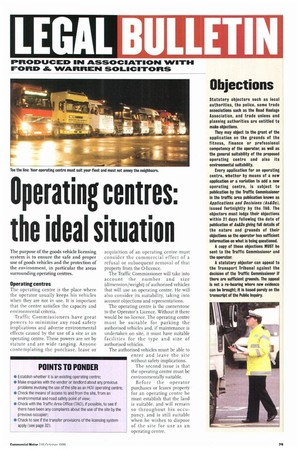Operating centres: the ideal situation
Page 31

If you've noticed an error in this article please click here to report it so we can fix it.
The purpose of the goods vehicle licensing system is to ensure the safe and proper use of goods vehicles and the protection of the environment, in particular the areas surrounding operating centres.
Operating centres The operating centre is the place where the operator usually keeps his vehicles when they are not in use. It is important that the centre satisfies the capacity arid environmental criteria.
Traffic Commissioners have great powers to minimise any road safety implications and adverse environmental effects caused by the use of a site as an operating centre. These powers are set by statute and are wide ranging. Anyone contemplating the purchase, lease or acquisition of an operating centre must consider the commercial effect of a refusal or subsequent removal of that property from the 0-licence.
The Traffic Commissioner will take into account the number and size (dimension/weight) of authorised vehicles that will use an operating centre. He will also consider its suitability, taking into account objections and representations.
The operating centre is the cornerstone to the Operator's Licence. Without it there would be no licence. The operating centre must be suitable for parking the authorised vehicles and, if maintenance is undertaken on site, it must have suitable facilities for the type and size of authorised vehicles.
The authorised vehicles must be able to enter and leave the site without safety implications.
The second issue is that the operating centre must be environmentally suitable.
Before the operator purchases or leases property for an operating centre he must establish that the land is suitable, and will remain so throughout his occupancy, and is still suitable when he wishes to dispose of the site for use as an operating centre.
POINTS TO PONDER
• Establish whether it is an existing operating centre; • Make enquiries with the vendor or landlord about any previous problems involving the use of the site as an FIGV operating centre;
• Check the means of ,iccess to and from the site, from an environmental and road safety point of view; • Check with the Traffic Area Office (TAO), if possible, to see if there have been any complaints about the use of the site by the previous occupier;
• Check to see if the transfer provisions of the licensing system apply (see page 32). .
Objections
Statutory objectors such as local authorities, the police, some trade associations such as the Road Haulage Association, and trade unions and planning authorities are entitled to make objections.
They may object to the grant of the application on the grounds of the fitness, finance or professional competency of the operator, as well as the general suitability of the proposed operating centre and also its environmental suitability.
Every application for an operating centre, whether by means of a new application or a variation to add a new operating centre, is subject to publication by the Traffic Commissioner in the traffic area publication known as Applications and Decisions (AsliDs), issued fortnightly by the TAO. The objectors must lodge their objections within 21 days following the date of publication of AscEDs giving full details of the nature and grounds of their objections so the operator has sufficient information on what is being questioned.
A copy of these objections MUST be sent to the Traffic Commissioner and the operator.
A statutory objector can appeal to the Transport Tribunal against the decision of the Traffic Commissioner if there are sufficient grounds. The appeal is not a re-hearing where new evidence can be brought; it is based purely on the transcript of the Public Inquiry.




















































































































